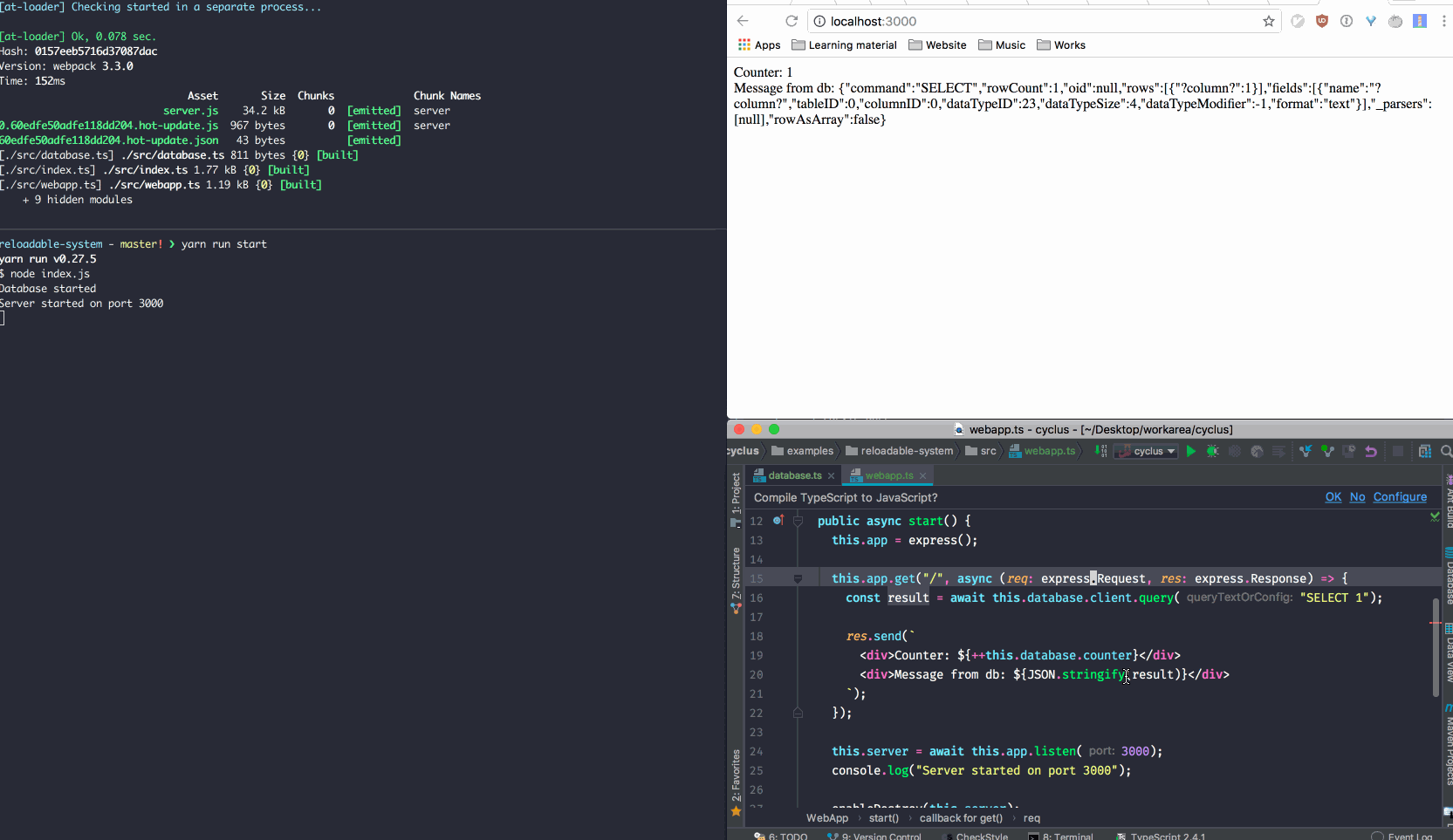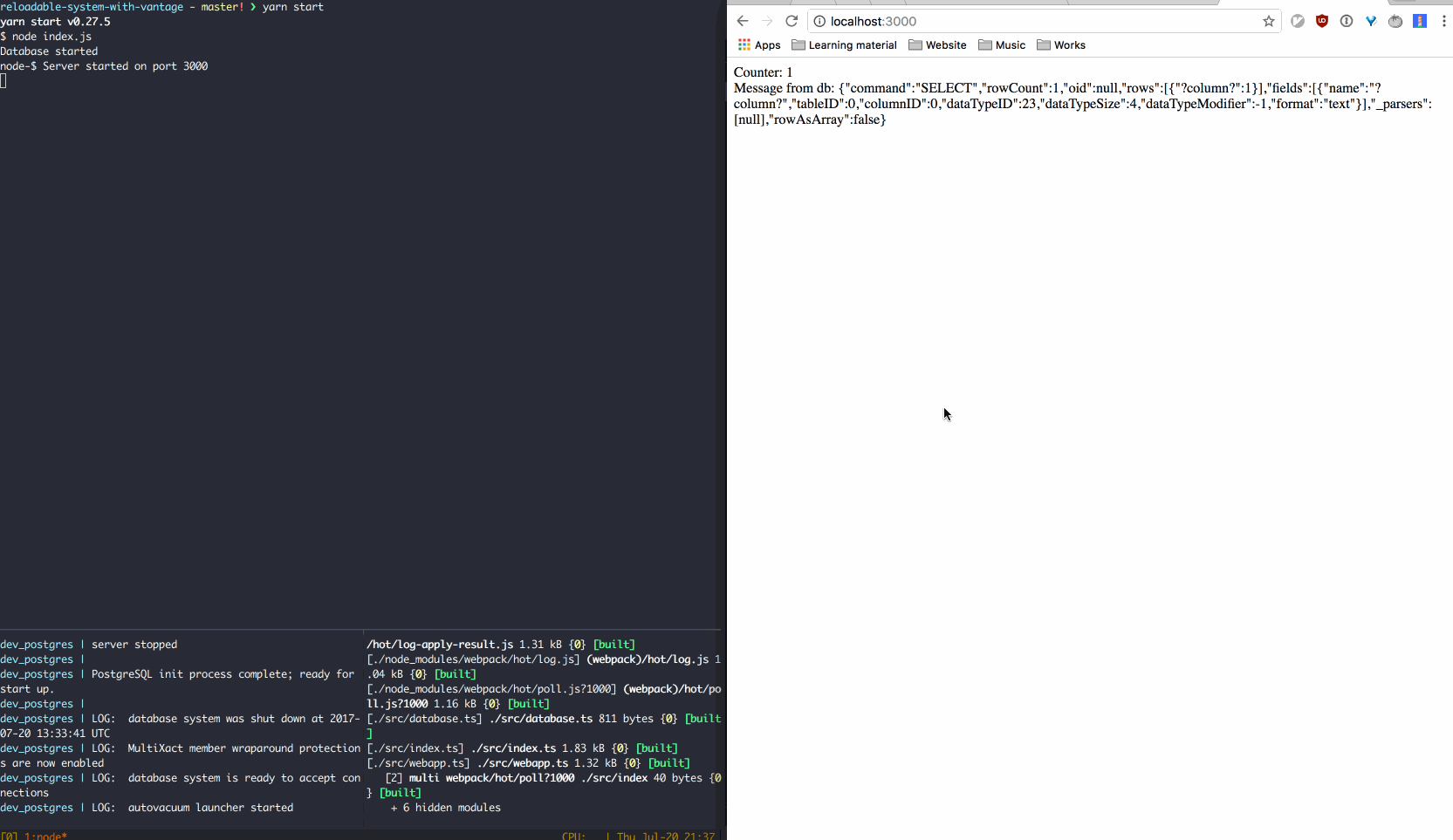'Cyclus' is a tiny lib for managing the lifecycle and dependencies of software components which have runtime state.
Inspire from 'Component' in clojure, make sure you read the document here
npm install cyclusimport { Lifecycle, SystemMap, using } from "cyclus";
// or import { Lifecycle, SystemMap, using } from "cyclus/dist/browser/cyclus";
// or import { Lifecycle, SystemMap, using } from "cyclus/dist/es5";
// or import { Lifecycle, SystemMap, using } from "cyclus/dist/es6";
// or import { Lifecycle, SystemMap, using } from "cyclus/dist/esnext";To create a component, define a class that extends Lifecycle class.
class Database extends Lifecycle {
dbConnection: string;
start() {
console.log("Start Database");
this.dbConnection = "OPENED";
}
stop() {
console.log("Stop Database");
this.dbConnection = "CLOSED";
}
}
class Scheduler extends Lifecycle {
tick: number;
start() {
console.log("Start Scheduler");
this.tick = 10;
}
stop() {
console.log("Stop Scheduler");
}
}Optionally, provide a constructor function that takes arguments for the essential configuration parameters of the component, leaving the runtime state blank.
const createDatabase = (): Lifecycle => new Database();Define other components in terms of the components on which they depend.
class ExampleComponent extends Lifecycle {
database: Database;
scheduler: Scheduler;
start() {
console.log("Start ExampleComponent");
}
stop() {
console.log("Stop ExampleComponent");
}
}Do not pass component dependencies in a constructor. Systems are responsible for injecting runtime dependencies into the components they contain: see the next section.
Components are composed into systems. A system is a component which knows how to start and stop other components. It is also responsible for injecting dependencies into the components which need them.
Specify the dependency relationships among components with the using
function. using takes a component and a collection of keys naming
that component's dependencies.
If the component and the system use the same keys, then you can specify dependencies as a array of keys:
const system = new SystemMap({
database: createDatabase(),
scheduler: createScheduler(),
exampleComponent: using(createExampleComponent(), [
"database",
"scheduler"
])
});If the component and the system use different keys, then specify
them as a map of { [component-key]: "system-key" }.
That is, the using keys match the keys in the component,
the values match keys in the system.
const system = new SystemMap({
db: createDatabase(),
sched: createScheduler(),
exampleComponent: using(createExampleComponent(), {
database: "db",
scheduler: "sched"
})
});
// ^ ^
// | |
// | \- Keys in the system map
// |
// \- Keys in the ExampleComponent recordThe system map provides its own implementation of the Lifecycle protocol which uses this dependency information (stored as metadata on each component) to start the components in the correct order.
Before starting each component, the system will assign its
dependencies based on the metadata provided by using.
Stop a system by calling the stop method on it. This will stop each
component, in reverse dependency order, and then re-assign the
dependencies of each component. Note: stop is not the exact
inverse of start; component dependencies will still be associated.
system.start();SystemMap can access object that is not an instance of LifeCycle component. Make sure you see all examples here
const system = new SystemMap({
inputChannel: csp.chan(1024),
resultChannel: csp.chan(1024),
db: new Database(config.database),
mailgun: new EmailService(config.mailgun),
worker: using(new Worker({ workFn: logAndSendEmails }), {
inputChannel: "inputChannel",
db: "db",
emailService: "mailgun",
resultChannel: "resultChannel"
}),
outgoingEmails: using(
new Queue(
Object.assign({}, config.outgoingEmails, {
outgoingMessagesChan: csp.chan()
})
),
{
incomingMessagesChan: "inputChannel"
}
),
sendEmails: using(
new Queue(
Object.assign({}, config.sendEmails, {
incomingMessagesChan: csp.chan()
})
),
{
outgoingMessagesChan: "resultChannel"
}
)
});Calling replace with given hashmap of new dependencies
system.replace({ database: createNewDatabase() }, { shouldRestart: true });This will automatically stop previous version of the database, and start a new one. Example for reloadable app
under example/reloadable-system
Additionally, { shouldRestart: [...someSystemKeys] } will receive an array of components. This will stop those
components and start them again.
system.replace({ database: createNewDatabase() }, { shouldRestart: ["scheduler"] });In this case, it will stop both database and scheduler then start them again
For many cases, gracefully restart won't work correctly due to the workload on each component. For example, we can't stop a database in the middle of heavy load from client. So the best way is to create a new instance, replace a running component, then stop old component
const oldDatabaseComponent = system.map.database;
const newDatabaseComponent = createNewDatabase();
await newDatabaseComponent.start();
await system.replace({ database: newDatabaseComponent });
await oldDatabaseComponent.stop(); // this has to process any remained request before existsystem.replace({ database: createFakeDatabase() })
system.start();start, stop, or replace will return a promise instead of running synchronously. So makes sure you wait for the
promise to resolve.
const order = [];
class Component1 extends Lifecycle {
async start() {
await timeout(1000);
order.push("Start component 1 after 1000");
}
async stop() {
await timeout(1000);
order.push("Stop component 1 after 1000");
}
}
class Component2 extends Lifecycle {
async start() {
await timeout(2000);
order.push("Start component 2 after 2000");
}
async stop() {
await timeout(2000);
order.push("Stop component 2 after 2000");
}
}
class Component3 extends Lifecycle {
component1: Component1;
component2: Component2;
start() {
order.push("Start component 3");
}
stop() {
order.push("Stop component 3");
}
}
const system = new SystemMap({
component1: createComponent1(),
component2: createComponent2(),
component3: using(createComponent3(), ["component1", "component2"])
});
system.start().then(() => {
// system started
// order = [
// "Start component 2 after 2000",
// "Start component 1 after 1000",
// "Start component 3"
// ];
});A system is idempotent, this means it doesn't how many time your trigger a system to start or stop,
it will behave as if you was calling it once. For example,
system.start();
system.start(); // => system.start();
system.start();After component initialized, it will create a map at .map from system, this is intended for internal access only.
This can be use to access component after they are started or stopped, but do not modify system.map directly, use
replace instead.
const system = new SystemMap({
component1: createComponent1(),
component2: createComponent2(),
component3: using(createComponent3(), ["component1", "component2"])
});
system.start().then(() => {
// system started
console.log(system.map); // => { component1, component2, component3 }
});
